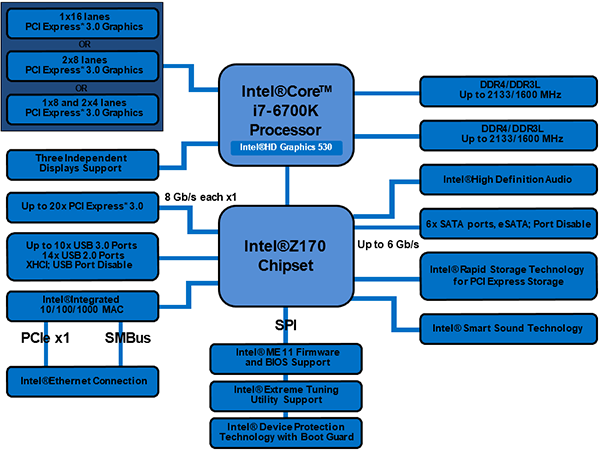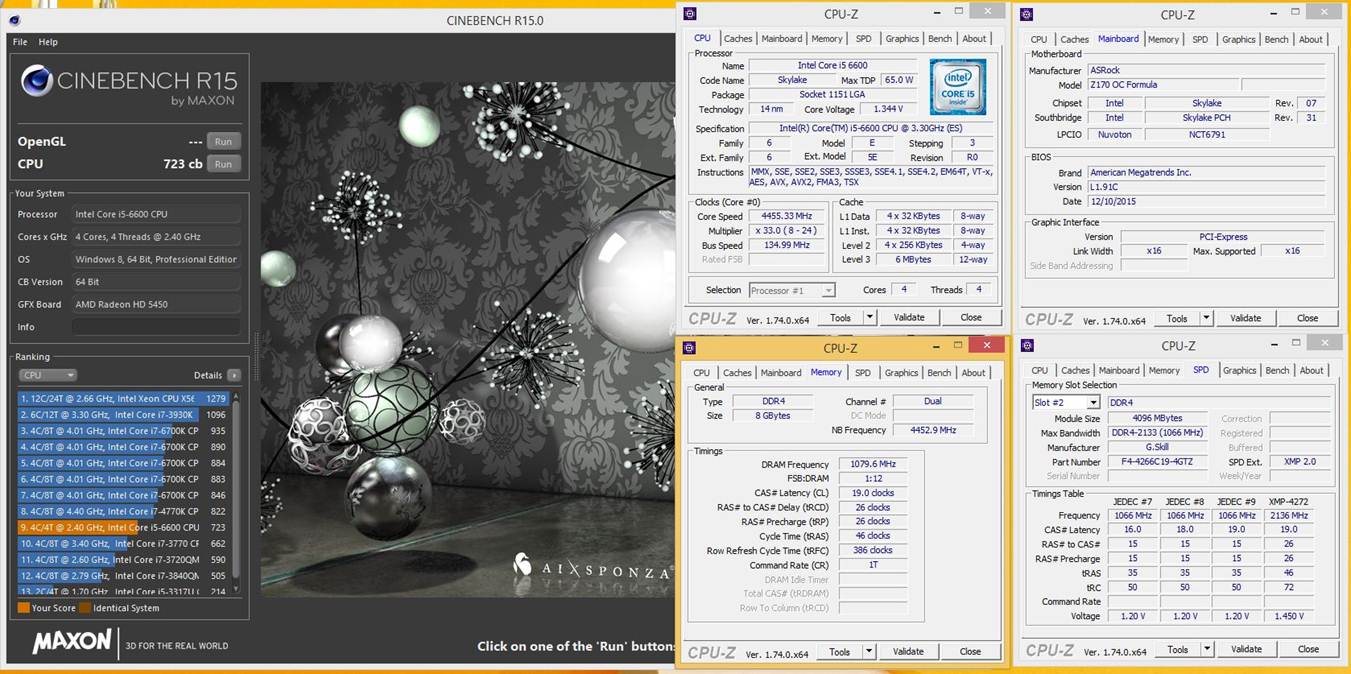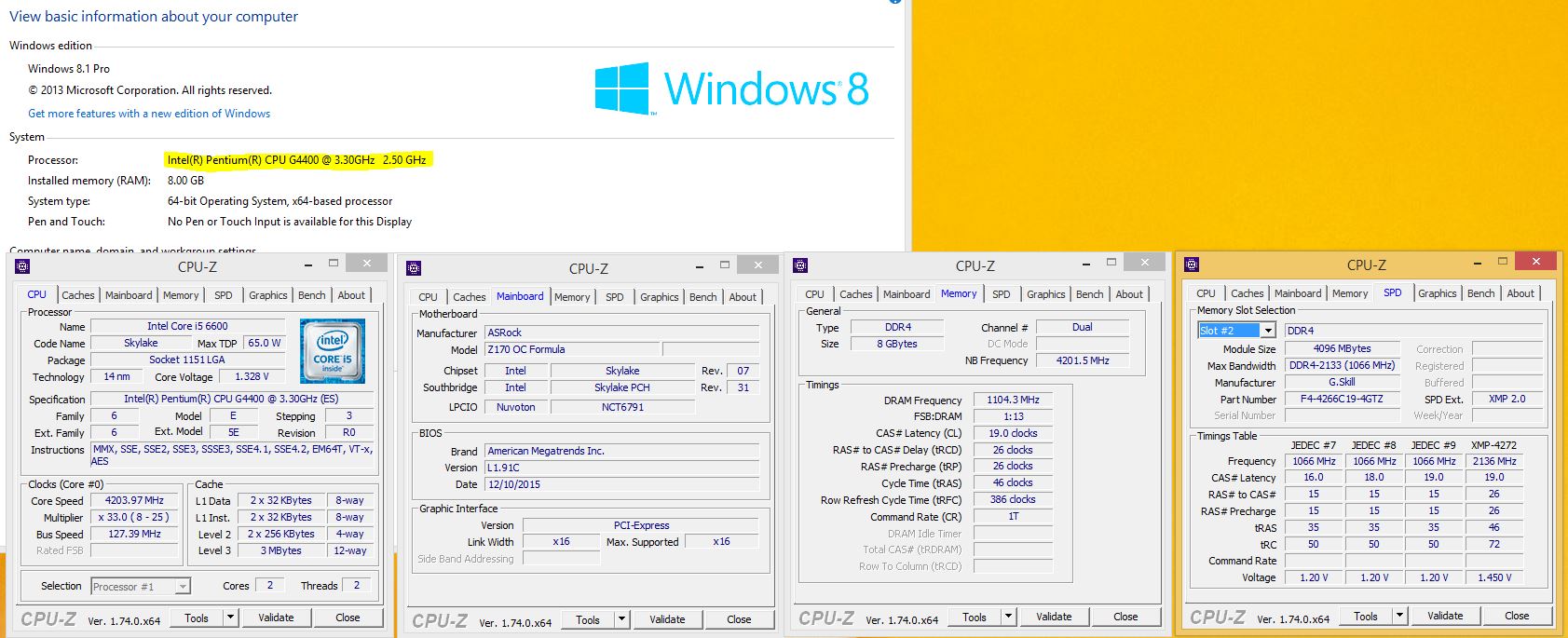Overclock Any Skylake CPU With The Right Motherboard
Remember the days when essentially every CPU on the market could be overclocked with the right motherboard? Although the CPU multiplier could sometimes be manipulated, in the past, overclocking a processor was done almost entirely by increasing the base clock of the system (the clock that numerous parts of the system use to determine the speed at which they operate).
This changed in recent years as AMD built most of its products with unlocked multipliers and as Intel released its Sandy Bridge microarchitecture, which would become unstable if the base clock was increased more than a few MHz. But with Intel’s new Skylake processors, users will once again be able to overclock essentially any 6th Gen (Skylake) processor by simply altering the base clock.
The Fall And Rebirth Of BCLK OC
At this time it isn’t clear what Intel changed to make base clock manipulation a viable method of overclocking again. The reason Intel’s Sandy Bridge, Ivy Bridge, Haswell and Broadwell processors were unable to attain high clock speeds by increasing the base clock was because of the tighter integration, as Intel migrated hardware that traditionally resided on the motherboard into the CPU core, most prominently the PCI-E and DMI controllers. As part of the CPU die itself, these controllers were also affected by changes in the system’s base clock, but are much less tolerant to changes in clock speed than the CPU cores. As a result, when overclocking one of these previous-gen processors by increasing the base clock, these controllers would quickly become unstable and cause the system to crash even if the CPU cores themselves were stable.
As it appears that Skylake CPUs do not do this, then either these components inside the CPU core are more capable of running at higher clock speeds, or, more likely, Intel has changed the inner workings of the CPU so that these controllers embedded in the processor do not increase their clock speed as the base clock rises. At this time, we can only speculate as to what has changed, but what we do know is that Intel’s Skylake CPUs can withstand much higher increases in the base clock than the last several generations of processors.
Motherboard Support
Officially, Intel’s Z170 chipsets are the only ones that support overclocking on the LGA 1151 socket at this time. It is possible that base clock manipulation is available on some non-Z170 motherboards, but we cannot confirm that presently. Asrock reps informed us that they did manage to overclock on a non-Z series motherboard, but that doing so required a hardware change. We were unable to get a clear answer about what kind of hardware change this is, so we cannot comment on whether it is something you’ll be able to do at home or not.
A Word Of Warning
Intel did not deny that this was possible, but when asked, an Intel representative told us, as expected, that "Intel does not recommend overclocking processors that have not been designed to do so. Intel does not warranty the operation of the processor beyond its specifications." So although it is technically possible, if you accidentally fry your CPU in the process, don’t expect Intel to replace it.
Asrock’s Overclock
We didn’t have a Skylake system immediately on hand to test this ourselves, but ASRock sent over a few screenshots to showcase its base clock overclocking results using an Intel Core i5-6600 on an ASRock Z170 OC Formula motherboard. With ASRock’s setup, the company was able to increase the base clock by roughly 35 percent, to 134.99 MHz. The Core i5-6600 has a base multiplier of 39, giving the CPU a clock speed of 4.45 GHz -- nearly a full gigahertz above the stock 3.3 GHz.
Get Tom's Hardware's best news and in-depth reviews, straight to your inbox.
Curiously, the i5-6600 supports Intel’s Turbo Boost technology to increase the CPU multiplier up to 39, which would result in a clock speed of 5264.61 MHz, but the CPU-Z screenshot provided by ASRock shows only a multiplier of 33 and a clock speed of 4.45 GHz, indicating that Turbo Boost is disabled. It isn’t clear why ASRock did this, but it was probably to maintain system stability while overclocking.
From the screenshots, we can also see that the North Bridge frequency also increased (as did the DRAM frequency) and is nearly the same clock speed as the CPU.
Asrock then tested the Core i5-6600 using Cinebench R15, which, according to the results, outperformed a stock hyperthreaded quad-core Intel Core i7-3770 in a multi-threaded workload. We cannot verify these results at this time, but if they are accurate, that is amazing performance out of this mid-range processor.
Asrock also tested out base clock overclocking on a dual-core Skylake Pentium G4400 CPU and was able to push the BLCK up roughly 27 percent to 127.39 MHz. CPU-Z did not read the processor accurately and listed it as a Core i5-6600, and it also showed a multiplier of 33 and some other information from the Core i5. The processor’s true multiplier value is 25, however, and with a base clock of 127.39, this resulted in a clock speed of 4.2 GHz.
What Does That Mean?
What all of the above means is that now, instead of just a handful of overclockable Intel CPUs on the market, we are faced with an entire series of parts that you can push to their limits. It is curious that Intel would make this possible on its CPUs, as it has always charged a premium for processors targeted at overclockers. If non-K processors can attain clock speeds comparable to the enthusiast K parts, Intel may have undermined the sales of its entire unlocked product series.
That is not to say that many overclockers won’t still probably shell out a couple extra bucks for an overclocking-oriented motherboard and CPU for the additional control having an unlocked multiplier gives them, but for budget overclockers, this may just be the free speed boost that we remember from the old days.
MORE: How to Overclock a CPU
______________________________________________________________________
Michael Justin Allen Sexton (or MJ) is a Contributing Writer for Tom's Hardware. As a tech enthusiast, MJ enjoys studying and writing about all areas of tech, but specializes in the study of chipsets and microprocessors. In his personal life, MJ spends most of his time gaming, practicing martial arts, studying history, and tinkering with electronics.
Follow Michael Justin Allen Sexton @EmperorSunLao. Follow us on Facebook, Google+, RSS, Twitter and YouTube.
-
jimmysmitty Intel has not always charged a premium for overclocking and never stopped BCLK overclocking per say. As you said the big issue was the integration of the PCIe and DMI controllers. The BCLKs clock generator was tied into all of them.Reply
From what I remember, Intel separated the clock generator in SKylake so instead of the 100MHz BCLK being tied to PCIe and DMI, it is its own clock generator making it capable of overclocking with the BCLK again.
I don't think that Intel ever was against overclocking with non K/X series CPUs but rather they sold those as a guarantee that this will overclock due to the unlocked multiplier while overclocking with the BCLK is much more of a shot in the dark due to chip quality. Most i5 2500Ks would hit 4.5GHz with a multiplier bump and a slight increase to the stock voltage. These SKylake CPUs will be much like a GPU now, they will vary depending on the quality of the chip and luck of the draw.
Still pretty cool if you can pay less for more. -
Onus It would appear that some H170 boards may be able to up the BCLK as well. I'll be looking into that...Reply -
quadrider21 Nice write up, I look forward to seeing some results that TH comes up with.Reply
This may sway my purchasing decision some in my next build. -
IInuyasha74 Well, they have had their "Extreme" products which are more OC friendly and enthusiast oriented since the Pentium 4 days. And yea BCLK OC was possible with the other CPUs, but extremely limited.Reply -
jimmysmitty Reply17126028 said:Well, they have had their "Extreme" products which are more OC friendly and enthusiast oriented since the Pentium 4 days. And yea BCLK OC was possible with the other CPUs, but extremely limited.
Yep. I had one. A S478 Pentium 4 EE, the first CPU with L3 as well.
But same can be said for any company. The AMD FX series was their top silicon that was best for OCing as well. BCLK overclocking has always been somewhat limited, multiplier is always better. -
IInuyasha74 Reply17126037 said:17126028 said:Well, they have had their "Extreme" products which are more OC friendly and enthusiast oriented since the Pentium 4 days. And yea BCLK OC was possible with the other CPUs, but extremely limited.
Yep. I had one. A S478 Pentium 4 EE, the first CPU with L3 as well.
But same can be said for any company. The AMD FX series was their top silicon that was best for OCing as well. BCLK overclocking has always been somewhat limited, multiplier is always better.
True :) -
ssdpro The problem now is the chips are binned into each SKU. The i7-6700 chips are clocked lower... for 30 bucks I would rather have a top binned CPU that wasn't put in the reject pile.Reply -
logainofhades As 4.0ghz seems to be easily obtainable, I would get the 6700, and use the $30 for cooling. Most games are not overly affected by clock speed, so 4.0ghz is plenty.Reply



